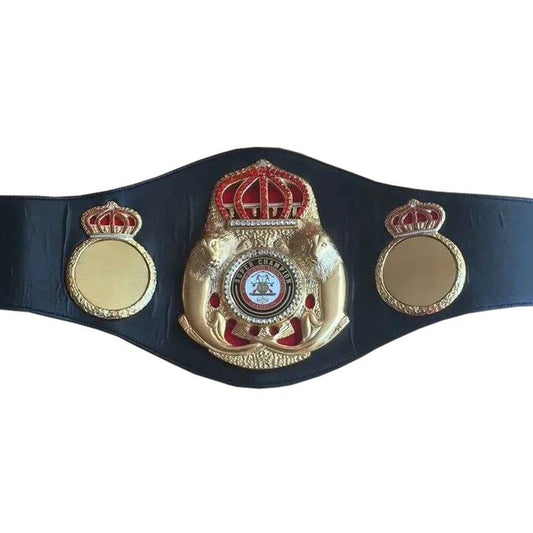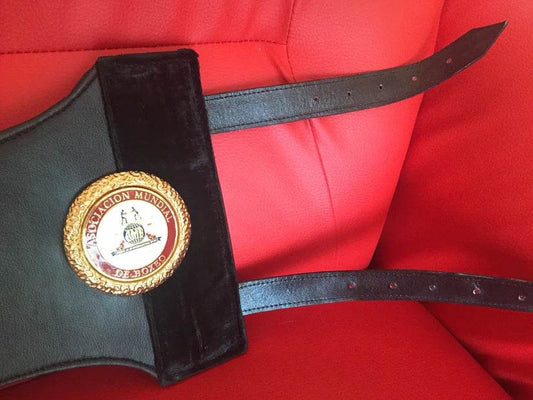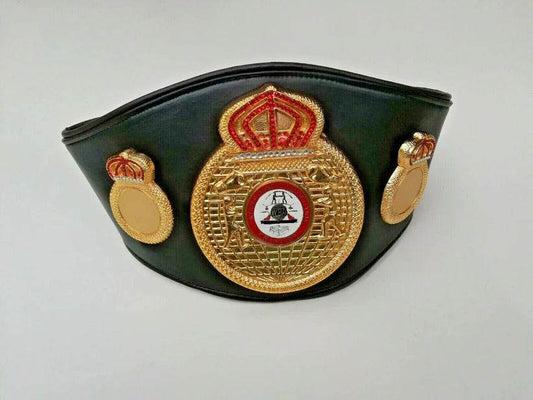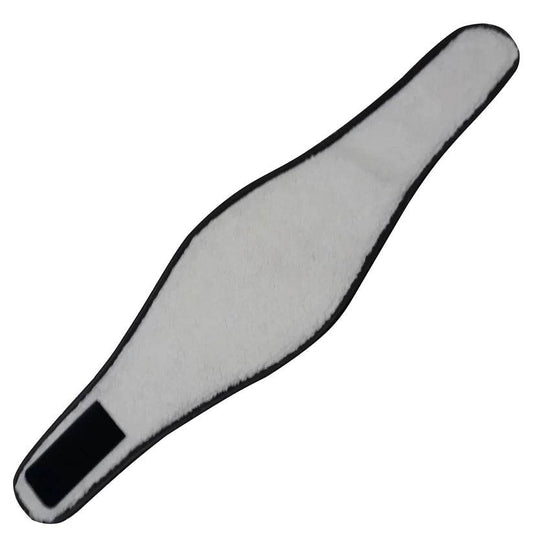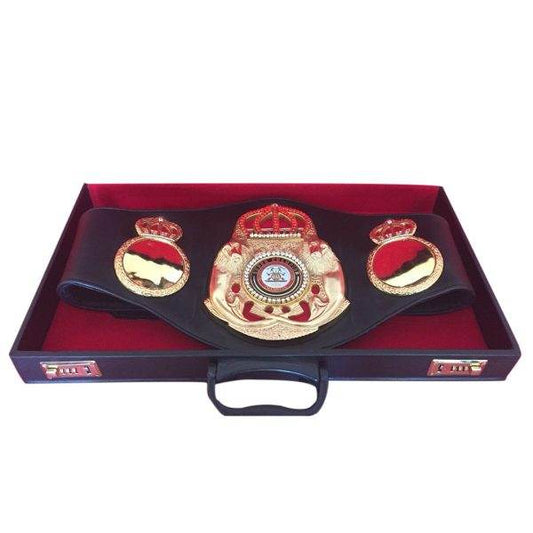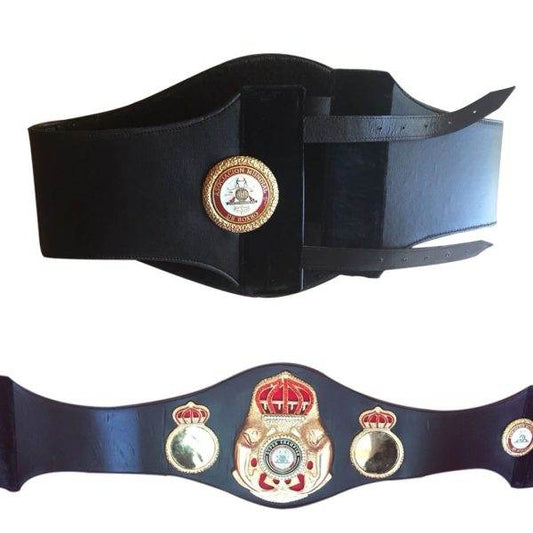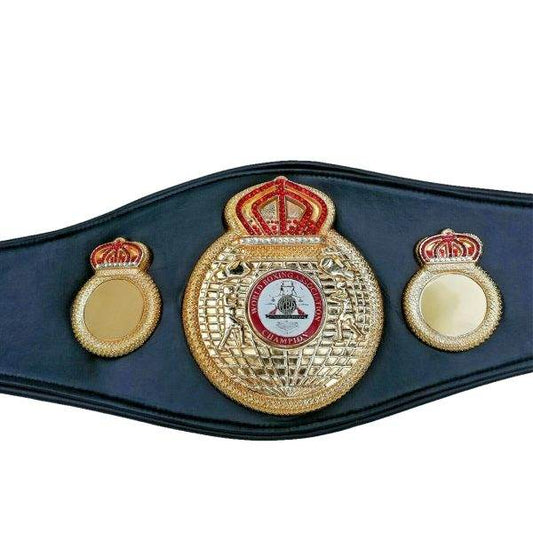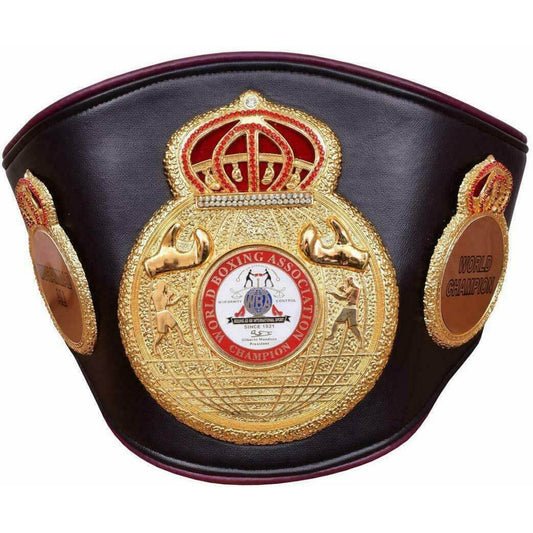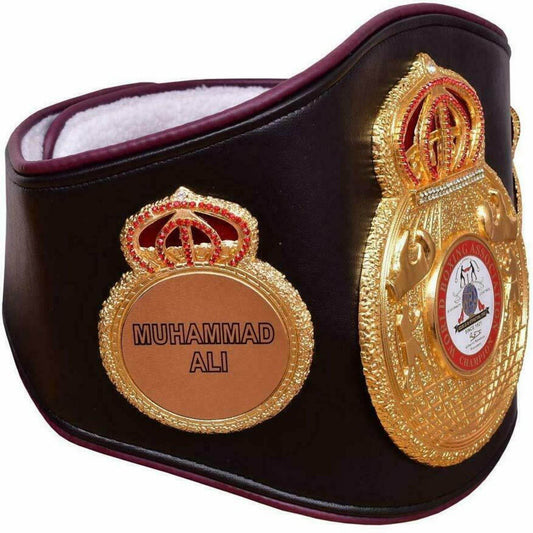-
WBA Super World Boxing Championship Belt
Regular price $199.00 USDRegular priceUnit price / per$250.00 USDSale price $199.00 USDSale -
WBA Title Boxing Championship Belt
Regular price $149.00 USDRegular priceUnit price / per$250.00 USDSale price $149.00 USDSale -
WBA SUPER WORLD Boxing Title Belt
4.5 / 5.0
(2) 2 total reviews
Regular price $199.00 USDRegular priceUnit price / per$250.00 USDSale price $199.00 USDSale -
WBA Boxing Championship Title Belt
4.5 / 5.0
(2) 2 total reviews
Regular price $149.00 USDRegular priceUnit price / per$250.00 USDSale price $149.00 USDSale -
WBA (World Boxing Association) Boxing Championship Replica Belt
4.5 / 5.0
(2) 2 total reviews
Regular price $149.00 USDRegular priceUnit price / per$200.00 USDSale price $149.00 USDSale
Collection: WBA Championship Belts
World Boxing Association Belt - WBA Belt - WBA Boxing Belts - WBA Super Belt - WBA Championship Belts

The WBA belt represents the pinnacle of achievement in professional boxing, standing as one of the most prestigious symbols in combat sports. As someone who has spent over fifteen years studying boxing history and collecting championship memorabilia, I can attest to the profound significance these belts hold within the boxing community. The World Boxing Association has maintained its position as boxing's oldest sanctioning body, and their championship belts continue to embody the highest standards of athletic excellence and competitive integrity.
When fighters step into the ring with dreams of championship glory, the WBA boxing belts represent more than just decorative accessories – they symbolize years of dedication, sacrifice, and the relentless pursuit of perfection. Each belt tells a story of triumph over adversity, of champions who have proven themselves against the world's elite competitors. The craftsmanship and design elements incorporated into these belts reflect the organization's commitment to honoring boxing's rich heritage while embracing modern manufacturing excellence.
The journey to earn a WBA super belt represents the ultimate achievement for professional boxers who have already proven themselves at the highest levels of competition. This special designation acknowledges fighters who have demonstrated exceptional dominance within their weight divisions, often by unifying titles or maintaining championship status across extended periods. The super belt classification adds an additional layer of prestige to an already coveted championship, creating a hierarchy that recognizes varying degrees of boxing excellence.
The Rich Heritage Behind Boxing's Most Coveted Prize
The WBA boxing belt has evolved significantly since the organization's establishment, incorporating design elements that reflect both traditional boxing aesthetics and contemporary artistic sensibilities. From my personal examination of various belt iterations over the years, I've observed how each design generation has maintained core symbolic elements while adapting to changing manufacturing capabilities and aesthetic preferences within the boxing community.
The central medallion of a WBA championship belt typically features the organization's iconic logo, surrounded by decorative elements that emphasize the global nature of professional boxing competition. The gold-plated finish has remained a consistent element throughout various design iterations, reinforcing the championship's association with excellence and achievement. The leather components are carefully selected and treated to ensure durability while maintaining the luxurious appearance expected of world championship accessories.
What makes these WBA belts particularly special is their connection to legendary boxing matches and career-defining moments. Every championship belt represents countless hours of training, strategic planning, and physical preparation that culminate in championship-level performance. The weight of these belts – both literally and figuratively – serves as a constant reminder of the responsibility that comes with being recognized as the world's best in a particular weight division.
Craftsmanship Excellence in Championship Belt Manufacturing
The production of authentic WBA replica belt versions requires sophisticated manufacturing processes that balance historical accuracy with practical considerations for collectors and enthusiasts. Modern replica manufacturers have invested heavily in research and development to ensure their products accurately represent the television versions carried by actual champions. The attention to detail in contemporary replicas has reached levels that were unimaginable just a decade ago.
The WBA belt boxing replicas available to collectors today incorporate many of the same materials and techniques used in creating the official championship versions. High-quality zinc alloy construction provides appropriate weight and substance, while genuine leather straps undergo careful selection and treatment processes to achieve the distinctive appearance associated with world championship boxing belts. The metalwork involves precision die-casting techniques that ensure consistent quality and accurate reproduction of intricate design elements.
From my experience handling various replica versions, the evolution in manufacturing quality has been remarkable. Early reproductions often featured simplified designs and basic materials that bore little resemblance to their television counterparts. Contemporary WBA boxing championship belt replicas demonstrate sophisticated understanding of the original designs, incorporating accurate proportions, detailed metalwork, and premium materials that create impressive display pieces for collectors and boxing enthusiasts.
The Significance of Championship Belt Design Elements
The visual language employed in WBA boxing belts design speaks to deeper themes within professional boxing culture. The central plate typically features bold lettering and symbolic imagery that reinforces the championship's position within the global boxing hierarchy. Side plates often incorporate decorative elements that reflect the organization's international scope and commitment to maintaining boxing's competitive integrity across diverse cultural contexts.
Color psychology plays a crucial role in championship belt aesthetics, with traditional gold finishes conveying prestige and achievement while creating visual associations with valuable metals and precious materials. The contrast between metallic elements and leather components enhances the overall visual impact while ensuring the belt photographs well under various lighting conditions during television broadcasts and promotional events.
The proportional relationships between different belt components have been refined over decades of design evolution, resulting in championship accessories that create maximum visual impact both in person and through various media formats. Television presentation requirements have influenced many design decisions, as championships must maintain their impressive appearance across different camera angles and broadcasting conditions while retaining their symbolic significance during live events.
Understanding the WBA Super Belt Classification System
The WBA super belt designation represents a relatively recent innovation within the organization's championship structure, created to address the complexities of modern professional boxing's multiple sanctioning body system. This classification acknowledges fighters who have demonstrated exceptional dominance within their weight divisions, often through title unification or extended championship reigns that exceed typical performance standards.
Earning super belt status requires more than simply winning a championship fight – it demands sustained excellence and often involves defeating other recognized champions or mandatory challengers within specified timeframes. This system creates additional motivation for champions to remain active and face top-level competition rather than pursuing less challenging optional defenses that might diminish the championship's competitive value.
The visual distinctions incorporated into super belt designs often include enhanced decorative elements, premium materials, or unique design features that differentiate them from standard championship versions. These modifications serve both symbolic and practical purposes, creating easily recognizable status indicators while maintaining the essential aesthetic elements that define WBA championship belts.
Market Dynamics and Collecting Trends
The market for WBA championship belt replicas has experienced significant growth as boxing's global popularity has expanded and manufacturing capabilities have improved. Price points now encompass everything from basic display pieces to premium collector editions that incorporate many of the same materials and construction techniques used in official championship versions.
Secondary market activity for rare and discontinued belt variants has created a robust collector economy, with certain limited edition releases achieving values substantially above their original retail prices. The WBA belts market demonstrates particular strength in regions with strong boxing traditions, where local champions and historical connections create additional demand drivers beyond general collecting interest.
Seasonal trends in championship belt sales often correlate with major boxing events and high-profile championship fights, creating predictable patterns that both manufacturers and collectors have learned to anticipate. The announcement of significant championship bouts typically generates increased interest in related belt replicas, benefiting both primary manufacturers and secondary market participants.
Authentication and Quality Assessment Standards
For serious collectors, developing expertise in distinguishing between authentic replicas and lower-quality reproductions has become essential for making informed purchasing decisions. Key quality indicators include metal weight and finish consistency, leather grain patterns and flexibility characteristics, stitching precision and durability, and overall construction attention to detail.
Authentic WBA-licensed replicas typically feature specific marking and packaging elements that help verify their legitimacy and distinguish them from unauthorized reproductions. Understanding these authentication markers requires experience and careful attention to details that develop over time through hands-on examination of various examples from different manufacturers and production periods.
Documentation and provenance tracking have become standard practices among serious collectors, with detailed records of purchase information, condition assessments, and authenticity verification helping maintain collection value while facilitating future transactions. The proliferation of online marketplaces has made these practices increasingly important for protecting collectors from fraudulent or misrepresented items.
Display and Preservation Best Practices
Proper display and preservation of WBA replica belt collections requires understanding of environmental factors that affect both metal and leather components over extended periods. Temperature stability, humidity control, and protection from direct sunlight help maintain appearance and structural integrity while preventing deterioration that could diminish both aesthetic appeal and monetary value.
Display options range from simple wall mounting systems to elaborate presentation cases that protect belts while showcasing their visual appeal to maximum advantage. The choice of display method often reflects both aesthetic preferences and practical considerations related to available space, security requirements, and integration with existing collection displays.
Maintenance routines for championship belt replicas typically involve periodic cleaning of metal components using appropriate materials that won't damage finishes, leather conditioning to prevent cracking and maintain flexibility, and hardware inspection to ensure continued structural soundness. These practices help preserve both appearance and value while extending the useful life of individual collection pieces.
The Global Impact of WBA Championship Recognition
The WBA boxing championship belt serves as a universal symbol of boxing excellence that transcends cultural and linguistic barriers, creating shared understanding among boxing enthusiasts worldwide. The organization's international scope means that WBA champions represent diverse backgrounds and fighting styles, contributing to the global appeal of these championship symbols.
Regional variations in boxing appreciation often influence collecting patterns and market dynamics, with certain belt designs or champion connections creating stronger demand in specific geographic markets. Understanding these regional preferences can be valuable for collectors seeking to maximize their investment potential or complete specific collection themes.
The historical significance of particular belt designs often correlates with memorable championship reigns or significant boxing events, creating additional collecting interest beyond the inherent appeal of the craftsmanship and materials involved. These historical connections help maintain long-term collecting interest while introducing new generations to boxing's rich competitive heritage.
Technical Specifications and Construction Methods
At WWFBelt.com, Modern WBA championship belt replicas employ sophisticated construction techniques that balance authenticity requirements with practical considerations for handling and display. Metal components typically utilize zinc alloy compositions that provide appropriate weight and durability while maintaining cost-effectiveness for commercial production scales.
The leather strap construction involves multiple stages, beginning with hide selection and preparation, followed by cutting, shaping, and finishing processes that create the distinctive appearance associated with professional boxing championships. Quality control measures ensure consistency across production runs while maintaining the high standards expected by discerning collectors.
Assembly processes involve precise alignment of metal plates with leather components, secure attachment of hardware elements, and final quality inspections that verify both aesthetic appearance and structural integrity. The balance between authenticity and practical usability represents a significant achievement in replica manufacturing, resulting in products that satisfy both serious collectors and casual boxing enthusiasts.
Innovation in Championship Belt Design Evolution
The continuous evolution of WBA belt designs reflects the organization's commitment to maintaining relevance while honoring boxing's traditional values and aesthetic preferences. Recent innovations have incorporated advanced manufacturing techniques, improved materials, and design elements that enhance both visual appeal and durability characteristics.
Technology integration in modern belt production has enabled more precise reproduction of intricate design elements while maintaining cost-effectiveness for commercial production. Computer-aided design systems allow for exact replication of complex decorative patterns while ensuring consistency across multiple production runs.
The feedback loop between collectors, manufacturers, and the WBA organization has contributed to ongoing improvements in replica quality and authenticity. This collaborative approach has resulted in products that increasingly satisfy the expectations of knowledgeable collectors while remaining accessible to boxing enthusiasts with varying levels of collecting experience and budget considerations.
The WBA boxing belt continues to represent the pinnacle of achievement in professional boxing, serving as both a competitive goal for active fighters and a cherished collectible for enthusiasts who appreciate the sport's rich history and cultural significance. The combination of exceptional craftsmanship, historical importance, and symbolic meaning ensures these belts will remain highly sought after by collectors and boxing fans for generations to come.
Through careful attention to manufacturing quality, historical accuracy, and collector preferences, modern replica producers have made it possible for boxing enthusiasts to own authentic representations of these prestigious championships. The continued refinement of production techniques and materials ensures that future generations will have access to even more impressive reproductions of these iconic symbols of boxing excellence.
Frequently Asked Questions (FAQs) About WBA Championship Belts:
-
1. What is the WBA Championship Belt?
The WBA (World Boxing Association) Championship Belt is awarded to fighters who win a WBA-sanctioned world title bout. It's one of the four major belts in professional boxing and symbolizes championship status within the WBA organization. -
2. What does WBA stand for in boxing?
WBA stands for World Boxing Association, one of the oldest and most prestigious boxing organizations in the world, founded in 1921 as the National Boxing Association. -
3. Who are some famous WBA champions?
Legendary boxers like Muhammad Ali, Sugar Ray Leonard, Mike Tyson, Manny Pacquiao, and Anthony Joshua have all held WBA titles during their careers. -
4. What weight classes does the WBA recognize?
The WBA currently recognizes 17 weight divisions, ranging from Minimumweight (105 lbs) to Heavyweight (unlimited), just like other major sanctioning bodies. -
5. How many champions can the WBA have per weight class?
The WBA has a controversial structure that often includes multiple champions per weight class, such as Super Champion, Regular Champion, and Interim Champion. -
6. What is a WBA Super Champion?
A WBA Super Champion is typically a unified titleholder or a long-reigning champion who meets specific criteria. This status is higher than that of a WBA Regular Champion. -
7. What is the difference between WBA Super and Regular Champion?
A Super Champion has achieved special recognition (like unifying multiple belts), while a Regular Champion is often a secondary titleholder in the same division. -
8. Are WBA belts recognized globally?
Yes, WBA belts are recognized worldwide and are considered legitimate world titles alongside WBC, IBF, and WBO titles. -
9. Can a fighter hold WBA and other titles at once?
Absolutely. Many top boxers unify belts across organizations, holding the WBA title along with WBC, IBF, or WBO belts in the same weight class. -
10. What does the WBA belt look like?
The WBA belt features a gold central plate, the WBA globe logo, and often has green or maroon leather straps, depending on the era and type of belt. -
11. How can someone win a WBA Championship Belt?
A fighter must win a WBA-sanctioned world title fight, typically against the current champion or for a vacant title if no champion is in place. -
12. What materials are WBA replica belts made of?
High-quality WBA replica belts are often made from genuine leather straps, metallic plates, and gold-plated detailing for an authentic look and feel. -
13. Are WBA belts collectible?
Yes, authentic and replica WBA belts are highly collectible, especially versions tied to famous fights or champions. They're popular among boxing fans and memorabilia collectors. -
14. Where can I buy a WBA Championship Belt replica?
WBA replica belts can be purchased from specialty boxing merchandise sites, sports memorabilia stores, and platforms like WWFBelt.com, eBay, and other authorized sellers. -
15. How much does a WBA belt replica cost?
Prices vary, but most WBA belt replicas range from $200 to $600, depending on the quality, materials, and authenticity of the design. -
16. Has the WBA unified with other boxing organizations?
While the WBA remains independent, it often participates in unification bouts, where fighters compete to hold titles from multiple organizations at once. -
17. How often does the WBA update its champion list?
The WBA updates its rankings and champions list monthly, and titles can change hands frequently based on scheduled bouts and mandatory defenses. -
18. Can fighters be stripped of WBA titles?
Yes, the WBA can strip a champion for failing to defend the title, violating regulations, or refusing mandatory challenges. -
19. Why does the WBA have so many champions?
The WBA has been criticized for its multiple-title system, which creates confusion. However, the organization claims it allows more opportunities for fighters worldwide. -
20. Is the WBA belt respected in boxing?
Despite criticisms about multiple titles per division, the WBA belt is still respected globally and has been held by some of the greatest boxers in history.

